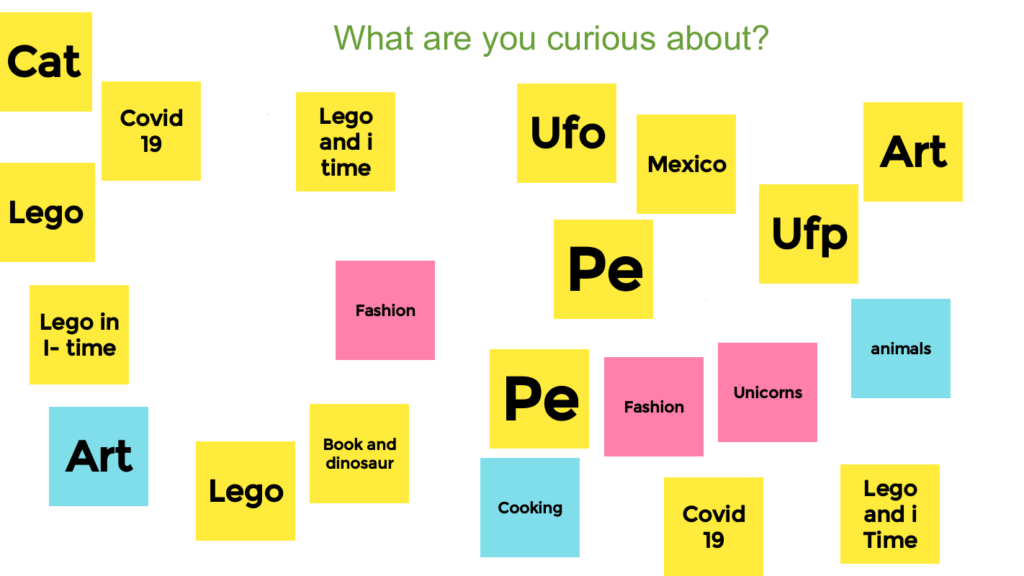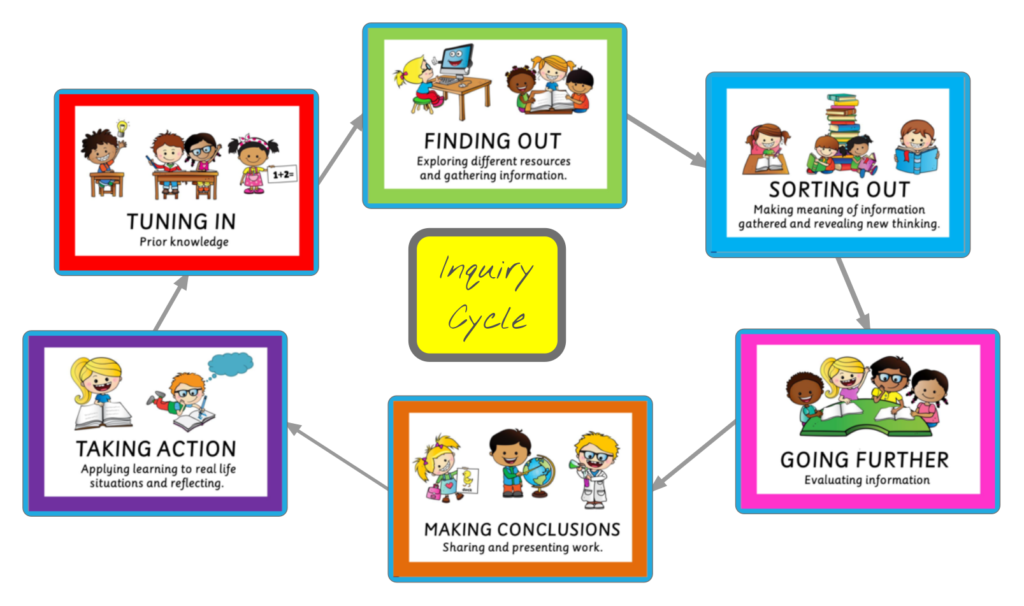Inquiry-based Learning and Digital Literacy

Completed by first graders using Google Jamboard
Inquiry-based Learning
“Inquiry-based learning is an approach to teaching and learning that places students’ questions, ideas and observations at the center of the learning experience” (Boiko & Nastas, 2017). Instilling curiosity or the eagerness to learn is the bedrock of inquiry-based learning. In an inquiry classroom, students are the ones who do the ‘heavy lifting’ of learning (Murdoch, 2015) – they question, they investigate, they research, they predict, they test their ideas, they analyze, they reflect, they forge connections with the world around them. Students are active participants, and though active can refer to physical activity and hands-on experiences, active inquiry learners are also active cognitively, as inquiry learning requires higher-order thinking (Murdoch, 2015).
Inquiry-based learning is not a novel concept in the educational arena. In fact, its roots can be traced to principles developed by John Dewey in the early 20th century (Won, 2010). The power of inquiry-based learning is that it activates the student as the manager of his/her own learning (Claxton, 2015) and promotes learner agency (Murdock, 2015). As students are involved in formulating questions based on their interests, they actively participate by gathering and analyzing information, and gradually develop a sense of ownership and responsibility as learners (Murdock, 2015).
There are many iterations of the cycle of inquiry. Using a framework for an inquiry gives shape to the inquiry itself. However, frameworks are not set in stone, nor are they meant to be followed strictly and with precision. Instead, the use of a framework for inquiry is meant to inform and support our thinking, planning and practice, while providing scaffolding for students. Bruce and Casey (2012), while proposing five dimensions or elements of the inquiry cycle, reiterate that the inquiry cycle often does not happen in a linear or simple fashion. With that in mind, the five elements they propose are ask, investigate, create, discuss and reflect.
- Ask – the journey of inquiry begins with questions that are fueled by curiosity and shaped by personal experiences
- Investigate – curiosity is transformed into action as learners study, gather information and make observations
- Create – learners actively create new meaning based on information gathered
- Discuss – brings in the aspect of collaboration and participation in a community of learners
- Reflect – looking back at the process of learning and determining next steps, whether it leads to further action or the beginning of a new inquiry
The framework or the cycle of inquiry that our school has used in the last several years is the one developed by Kath Murdoch (2015). I have explained it briefly here:
- Framing the inquiry – establishing a context and a question, while identifying goals and specific links to school curriculum
- Tuning in – this is where the provocations/essential questions are introduced to spark interest, curiosity and tension; gather data about students’ prior knowledge and understanding
- Finding out – gather new information to address the questions, research and collaborate to develop shared understandings and record information gathered
- Sorting out – provide answers to essential questions, make meaning of new information and synthesize data gathered
- Going further – pursue new questions that might have been generated during earlier parts of the inquiry cycle; teachers release increased responsibility to students
- Reflecting and acting – students take stock of their learning and set goals for the future; apply learning to new situations, take action
- Evaluating – reviewing the inquiry process to identify strengths and weak spots and determining steps for future planning
Here is an earlier iteration of Kath Murdoch’s inquiry cycle:

Example from my classroom
In Figure 1, I asked my class the question: “What are you curious about?” This was a follow up session from our time in the Makerspace the day before, where many students tinkered with Lego Robotics kits and tried sewing stuffed toys. Using the model developed by Kath Murdoch, this phase would be in the ‘framing the inquiry’ portion. We used Google Jamboard, so students can see each other’s ideas and spark a conversation amongst each other about why they chose the ideas they wrote down.
What did this activity reveal to me?
Students submitted responses that I would categorize as ‘expected’ – animals, Legos, unicorns, books, art and PE. Obviously, these are some of the things they enjoy doing. What surprised me was the fact that Covid 19 came up twice. The next step in this process is to tune-in to what kids are telling me and provide a provocation that builds upon these responses. What do they already know about Covid 19 and what do they want to know? I’m excited to see where this inquiry takes us.
Digital Literacy

According to this definition, the concept of digital literacy has 3 main components: the knowledge of current digital tools, critical thinking or the ability to locate, gather and evaluate information, and social engagement, which is the collaborative and participatory element of digital literacy. In addition, Pow and Fu (2012) define digital literacy as “the ability to understand and use information in multiple formats, from a wide range of sources, when presented via a computer” (p. 287). ISTE Student Standard 1.3.c states that “Students curate information from digital resources using a variety of tools and methods to create collections of artifacts that demonstrate meaningful connections or conclusions” (International Society for Technology in Education [ISTE], n.d.). In this increasingly technological world and highly digitized society we live in, inquiry teachers help students learn digital literacy skills, such as locating and accessing information using multiple formats, gathering resources and evaluating the massive influx of information with the help of a plethora of digital tools (Murdoch, 2015). ISTE Student Standard 1.3.d Students build knowledge by actively exploring real-world issues and problems, developing ideas and theories and pursuing answers and solutions is evident in contemporary inquiry strategies that promote student engagement in real-world issues by providing authentic contexts to students’ investigations (Murdock, 2015). “In the inquiry process, students are active constructors of knowledge, and the teacher is a facilitator of their learning” (Chu, Chow & Tse, 2012). What used to be optional skills to have, digital literacy skills are now considered essential in order for students to thrive and move forward in the current climate (Bruce and Casey, 2012).
The inquiry-based approach to learning and proficiency in digital literacy work hand in hand to develop deep learning. According to ResourceEd (2017), there are 6 core skills in digital literacy that promote deep learning, and these core skills are also evident in an inquiry classroom. These are:
- Collaboration – the ability to work effectively with others and be part of a team; share your ideas with others
- Creativity – formulate the right questions to generate new ideas
- Critical thinking – evaluate information, sources and methods, highlight patterns and connections
- Citizenship – being open-minded and accept others’ abilities concerning issues, solve complex problems together
- Character – perseverance and hard work produce good outcomes
- Communication – clear and effective dissemination of information using a mix of tools for varied audiences
Final thoughts
Putting the needs of students at the center always yields the right results. Using the inquiry-based approach to learning, where students are given the opportunity to ask their own questions and investigate topics that are important to them, is a powerful way of motivating students to learn and stay engaged. Guided and equipped by the technological advancements in our society, students can use the appropriate digital tools to help them develop critical thinking skills to evaluate information, build connections to real-world situations and make a positive contribution to their communities.
References
Boiko, M. & Nastas, D. (2017, January). Tools for inquiry-based learning in primary school. Open Educational E-Environment of Modern University. 42-54.DOI: 10.28925/2414-0325.2017.3.4354
Bruce, B. C. & Casey, L. (2012). The practice of inquiry: A pedagogical ‘sweet spot’ for digital literacy? Computers in the Schools, Special Issue on Signature Pedagogies, 29(1-2), 191-206.
Chu, S. K. W., Chow, K. & Tse, S. K. (2011). Using collaborative teaching and inquiry project-based learning to help primary school students develop information literacy and information skills. Library & Information Science Research, 33, 132-143.
Claxton, G. (2015). Foreword. In Murdoch, K. The power of inquiry. Seastar Education. 4-5.
International Society for Technology in Education. n.d. International standards: Students. https://www.iste.org/standards/iste-standards-for-students
Murdoch, K. (2015). The power of inquiry. Seastar Education.
Pow, J. & Fu, J. (2012). Developing digital literacy through collaborative inquiry learning in the Web 2.0 environment – An exploration of implementing strategy. Journal of Information Technology Education: Research, 11, 287-299.
ResourceEd A Promethean Blog. (2017). Digital literacy in the classroom. How important is it?
Won, M. (2009). Issues in inquiry-based science education seen through Dewey’s theory of inquiry. [Doctoral dissertation, University of Illinois at Urbana-Champaign].

😁
😁 facial comment.
Chelly, I love how you have given us a step-by-step guide of how this works in your classroom. It makes me think how can the process be narrowed down to a more specific subject area, like ELA. Thank you for the wonderful resources and a guide on how to make this process work.
Chelly,
As someone who has not taught solely before, I appreciate how smooth you process your steps in this inquiry-based learning activity. What a great graphic to share! This makes me think of the Securly search bar I constantly check on my sons computer, which I am thankful the school district contracted. So many wonderful subjects from Legos to farts. Childrens minds are so inquisitive and I love this activity for them. Thank you for sharing and helping us visualize how this looks like for you as the teacher!